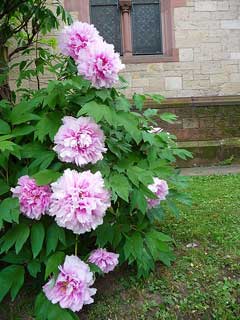
Moutan, Moutan peony, Tree Peony, Japanese Tree Peony
Latin Name: Paeonia suffruticosa
USDA Hardiness: 5-8
Native Range: Coming Soon
Edibility Rating: 1 / 5
Medicinal Rating: 2 / 5
Region:
Family:
Plant Type:
Medicinal Uses
Edible Uses
Edible Parts: Flowers | Edible Uses: Flowers - cooked[46, 61, 177]. The fallen flower petals are parboiled and sweetened for a teatime delicacy, or cooked in various dishes[183].
Cultivation
Landscape Uses:Border, Foundation, Seashore, Specimen. Requires a deep rich soil, preferably neutral or slightly alkaline[1], doing quite well in sun or light shade[1]. Prefers a limy soil and a sheltered position[200]. Plants are tolerant of a wide range of soil conditions, but will not survive if the soil becomes waterlogged or is too dry[250]. This species is lime tolerant[200]. Plants grown on sandy soils tend to produce more leaves and less flowers, whilst those growing on clay take longer to become established but produce better blooms[250]. Hardy to about -20°c[184], plants do better in the north of Britain than they do in the south and are generally best if given an open northerly aspect[11]. Plants come into growth early in the year and are then subject to damage by late frosts, they are therefore best sited in a position that is shaded from the early morning sun[11]. The branches are brittle and very subject to wind damage, especially when young[200]. There is some confusion over the name of this species, Chinese botanists believing that it was based on a cultivar. They do not recognise this name, instead raising to specific status two of its sub-species as P. rockii (Haw.&Lauener.) Hong.&Li. and P. jishanensis Hong.&W.Z.Zhao (syn P. spontanea (Rehder.) Hong.&W.Z.Zhao.)[214]. Most modern treatments no longer recognise this as a separate species, though some people use the name to house the large number of garden forms of tree peonies that have been developed over the centuries[250]. A very ornamental plant[1], there are many named varieties[182]. It grows best in areas with long hot summers[1] and requires an airy position because it is very subject to fungal attack[11]. Plants in this genus are notably susceptible to honey fungus[200]. The flowers of some forms of this species are pleasantly scented[245]. Scented forms include 'Flora', 'Fragrans Maxima', 'Kimpai' and 'Kokuho'[245]. Members of this genus are rarely if ever troubled by browsing deer or rabbits[233]. A very greedy plant inhibiting the growth of nearby plants, especially legumes[54]. The plant does not really need much pruning apart from removing dead or diseased stems. It is, however, very tolerant of pruning and can be cut right back to ground level if it requires rejuvenation[200]. Strongly resents root disturbance, taking some time to recover after being divided[1]. Peony species are usually self-fertile, though they will also hybridise with other species if these flower nearby at the same time[250]. Plants take 4 - 5 years to flower from seed[200]. They generally breed true from seed[1]. Cultivated in China as a medicinal plant[214]. Special Features:Attractive foliage, Naturalizing, Suitable for cut flowers, Suitable for dried flowers, Fragrant flowers.
Known Hazards
None known
Habitats
Scrub in mountains[184]. Cliffs at elevations around 300 metres[266].
